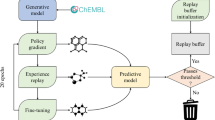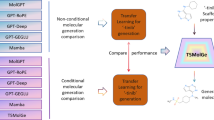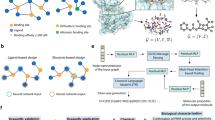Abstract
Deep generative models are gaining attention in the field of de novo drug design. However, the rational design of ligand molecules for novel targets remains challenging, particularly in controlling the properties of the generated molecules. Here, inspired by the DNA-encoded compound library technique, we introduce DeepBlock, a deep learning approach for block-based ligand generation tailored to target protein sequences while enabling precise property control. DeepBlock neatly divides the generation process into two steps: building blocks generation and molecule reconstruction, accomplished by a neural network and a rule-based reconstruction algorithm we proposed, respectively. Furthermore, DeepBlock synergizes the optimization algorithm and deep learning to regulate the properties of the generated molecules. Experiments show that DeepBlock outperforms existing methods in generating ligands with affinity, synthetic accessibility and drug likeness. Moreover, when integrated with simulated annealing or Bayesian optimization using toxicity as the optimization objective, DeepBlock successfully generates ligands with low toxicity while preserving affinity with the target.
This is a preview of subscription content, access via your institution
Access options
Access Nature and 54 other Nature Portfolio journals
Get Nature+, our best-value online-access subscription
27,99 € / 30 days
cancel any time
Subscribe to this journal
Receive 12 digital issues and online access to articles
99,00 € per year
only 8,25 € per issue
Buy this article
- Purchase on SpringerLink
- Instant access to full article PDF
Prices may be subject to local taxes which are calculated during checkout






Similar content being viewed by others
Data availability
Source data for Figs. 2–6 are provided with this paper. All of the datasets used in this study are publicly available. The raw data of the CrossDocked 2020 dataset were obtained from https://github.com/gnina/models/tree/master/data/CrossDocked2020. The dataset for pretraining BGNet were obtained from ChEMBL dataset (https://ftp.ebi.ac.uk/pub/databases/chembl/ChEMBLdb/releases/chembl_31/). The processed datasets used to train the model are available via figshare56 at https://figshare.com/articles/dataset/crossdocked_pocket10_with_protein_tar_gz/25878871. The small-mouse intraperitoneal LD50 sub-dataset was obtained from TOXRIC (https://toxric.bioinforai.tech/home).
Code availability
The source code and weights of trained models are available on GitHub at https://github.com/BioChemAI/DeepBlock and deposited on Zenodo at https://doi.org/10.5281/zenodo.13852436 (ref. 57).
References
Shoichet, B. K. Virtual screening of chemical libraries. Nature 432, 862–865 (2004).
Meyers, J., Fabian, B. & Brown, N. De novo molecular design and generative models. Drug Discov. Today 26, 2707–2715 (2021).
Wang, M. et al. Deep learning approaches for de novo drug design: an overview. Curr. Opin. Struc. Biol. 72, 135–144 (2022).
Segler, M. H., Kogej, T., Tyrchan, C. & Waller, M. P. Generating focused molecule libraries for drug discovery with recurrent neural networks. ACS Cent. Sci. 4, 120–131 (2018).
Moret, M., Friedrich, L., Grisoni, F., Merk, D. & Schneider, G. Generative molecular design in low data regimes. Nat. Mach. Intell. 2, 171–180 (2020).
Gómez-Bombarelli, R. et al. Automatic chemical design using a data-driven continuous representation of molecules. ACS Cent. Sci. 4, 268–276 (2018).
Jin, W., Barzilay, R. & Jaakkola, T. Junction tree variational autoencoder for molecular graph generation. In Proc. 35th International Conference on Machine Learning, Proc. Machine Learning Research Vol. 80 (eds Dy, J. & Krause, A.) 2323–2332 (PMLR, 2018).
Li, Y., Zhang, L. & Liu, Z. Multi-objective de novo drug design with conditional graph generative model. J. Cheminform. 10, 33 (2018).
Putin, E. et al. Reinforced adversarial neural computer for de novo molecular design. J. Chem. Inf. Model. 58, 1194–1204 (2018).
Zang, C. & Wang, F. Moflow: an invertible flow model for generating molecular graphs. In Proc. 26th ACM SIGKDD International Conference on Knowledge Discovery & Data Mining 617–626 (ACM, 2020).
Kuznetsov, M. & Polykovskiy, D. MolGrow: a graph normalizing flow for hierarchical molecular generation. Proc. AAAI Conf. Artif. Intell. 35, 8226–8234 (2021).
Hoogeboom, E., Satorras, V. G., Vignac, C. & Welling, M. Equivariant diffusion for molecule generation in 3D. In Proc. 39th International Conference on Machine Learning, Proc. Machine Learning Research Vol. 162 (eds Chaudhuri, K. et al.) 8867–8887 (PMLR, 2022).
Schneuing, A. et al. Structure-based drug design with equivariant diffusion models. Preprint at https://arxiv.org/abs/2210.13695 (2022).
Li, J. et al. Mining for potent inhibitors through artificial intelligence and physics: a unified methodology for ligand based and structure based drug design. J. Chem. Inf. Model. https://doi.org/10.1021/acs.jcim.4c00634 (2024).
Ragoza, M., Masuda, T. & Koes, D. R. Generating 3D molecules conditional on receptor binding sites with deep generative models. Chem. Sci. 13, 2701–2713 (2022).
Luo, S., Guan, J., Ma, J. & Peng, J. A 3D generative model for structure-based drug design. Adv. Neural Inf. Process. Syst. 34, 6229–6239 (2021).
Gao, W. & Coley, C. W. The synthesizability of molecules proposed by generative models. J. Chem. Inf. Model. 60, 5714–5723 (2020).
Brenner, S. & Lerner, R. A. Encoded combinatorial chemistry. Proc. Natl Acad. Sci. USA 89, 5381–5383 (1992).
Liu, R., Li, X. & Lam, K. S. Combinatorial chemistry in drug discovery. Curr. Opin. Chem. Biol. 38, 117–126 (2017).
Bertsimas, D. & Tsitsiklis, J. Simulated annealing. Stat. Sci. 8, 10–15 (1993).
Lin, Z. et al. Evolutionary-scale prediction of atomic-level protein structure with a language model. Science 379, 1123–1130 (2023).
Degen, J., Wegscheid-Gerlach, C., Zaliani, A. & Rarey, M. On the art of compiling and using ‘drug-like’ chemical fragment spaces. ChemMedChem 3, 1503–1507 (2008).
Mendez, D. et al. ChEMBL: towards direct deposition of bioassay data. Nucleic Acids Res. 47, D930–D940 (2019).
Wang, R., Fang, X., Lu, Y. & Wang, S. The PDBbind database: collection of binding affinities for protein–ligand complexes with known three-dimensional structures. J. Med. Chem. 47, 2977–2980 (2004).
Jessani, N., Liu, Y., Humphrey, M. & Cravatt, B. F. Enzyme activity profiles of the secreted and membrane proteome that depict cancer cell invasiveness. Proc. Natl Acad. Sci. USA 99, 10335–10340 (2002).
Chiang, K. P., Niessen, S., Saghatelian, A. & Cravatt, B. F. An enzyme that regulates ether lipid signaling pathways in cancer annotated by multidimensional profiling. Chem. Biol. 13, 1041–1050 (2006).
Chang, J. W., Nomura, D. K. & Cravatt, B. F. A potent and selective inhibitor of KIAA1363/AADACL1 that impairs prostate cancer pathogenesis. Chem. Biol. 18, 476–484 (2011).
Francoeur, P. G. et al. Three-dimensional convolutional neural networks and a cross-docked data set for structure-based drug design. J. Chem. Inf. Model. 60, 4200–4215 (2020).
Steinegger, M. & Söding, J. mmseqs2 enables sensitive protein sequence searching for the analysis of massive data sets. Nat. Biotechnol. 35, 1026–1028 (2017).
Jänne, P. et al. KRYSTAL-1: activity and safety of adagrasib (MRTX849) in advanced/metastatic non-small cell lung cancer (NSCLC) harboring KRASG12C mutation. Eur. J. Cancer 138, S1–S2 (2020).
Landrum, G. RDKit: open-source cheminformatics. RDKit http://www.rdkit.org (2006).
Zhao, T., Zhao, R. & Eskenazi, M. Learning discourse-level diversity for neural dialog models using conditional variational autoencoders. In Proc. 55th Annual Meeting of the Association for Computational Linguistics Vol. 1 (eds Barzilay, R. & Kan, M.) 654–664 (ACL, 2017).
Kingma, D. P. & Welling, M. Auto-encoding variational Bayes. Preprint at https://arxiv.org/abs/1312.6114 (2014).
Chung, J., Gulcehre, C., Cho, K. & Bengio, Y. Empirical evaluation of gated recurrent neural networks on sequence modeling. Preprint at https://arxiv.org/abs/1412.3555 (2014).
Devlin, J., Chang, M.-W., Lee, K. & Toutanova, K. BERT: pre-training of deep bidirectional transformers for language understanding. In Proc. North American Chapter of the Association for Computational Linguistics Vol. 1 (eds Burstein, J. et al.) 4171–4186 (ACL, 2019).
Kingma, D. P. & Ba, J. Adam: a method for stochastic optimization. Preprint at https://arxiv.org/abs/1412.6980 (2015).
Bowman, S. R. et al. Generating sentences from a continuous space. In Proc. 20th SIGNLL Conference on Computational Natural Language Learning (eds Riezler, S. & Goldberg, Y.) 10–21 (ACL, 2016).
Riniker, S. & Landrum, G. A. Better informed distance geometry: using what we know to improve conformation generation. J. Chem. Inf. Model. 55, 2562–2574 (2015).
Metropolis, N., Rosenbluth, A. W., Rosenbluth, M. N., Teller, A. H. & Teller, E. Equation of state calculations by fast computing machines. J. Chem. Phys. 21, 1087–1092 (1953).
Kirkpatrick, S., Gelatt, C. D. & Vecchi, M. P. Optimization by simulated annealing. Science 220, 671–680 (1983).
Bajusz, D., Rácz, A. & Héberger, K. Why is Tanimoto index an appropriate choice for fingerprint-based similarity calculations? J. Cheminform. 7, 20 (2015).
Jain, S. et al. Large-scale modeling of multispecies acute toxicity end points using consensus of multitask deep learning methods. J. Chem. Inf. Model. 61, 653–663 (2021).
Liwanag, P. M., Hudson, V. W. & Hazard, G. F. Jr. ChemIDplus: a web-based chemical search system. NLM https://www.nlm.nih.gov/pubs/techbull/ma00/ma00_chemid.html (2000).
Wu, L. et al. TOXRIC: a comprehensive database of toxicological data and benchmarks. Nucleic Acids Res. 51, D1432–D1445 (2023).
Durant, J. L., Leland, B. A., Henry, D. R. & Nourse, J. G. Reoptimization of mdl keys for use in drug discovery. J. Chem. Inf. Comput. Sci. 42, 1273–1280 (2002).
Le, T. T., Fu, W. & Moore, J. H. Scaling tree-based automated machine learning to biomedical big data with a feature set selector. Bioinformatics 36, 250–256 (2020).
Cao, Y., Goodin, D. & Mcree, D. Probing the strength and character of an Asp-His-x hydrogen bond by introducing buried charges. PDB https://doi.org/10.2210/pdb1a2g/pdb (1998).
Alhossary, A., Handoko, S. D., Mu, Y. & Kwoh, C.-K. Fast, accurate, and reliable molecular docking with QuickVina 2. Bioinformatics 31, 2214–2216 (2015).
Trott, O. & Olson, A. J. AutoDock Vina: improving the speed and accuracy of docking with a new scoring function, efficient optimization, and multithreading. J. Comput. Chem. 31, 455–461 (2010).
Eberhardt, J., Santos-Martins, D., Tillack, A. F. & Forli, S. AutoDock Vina 1.2. 0: new docking methods, expanded force field, and Python bindings. J. Chem. Inf. Model. 61, 3891–3898 (2021).
Bickerton, G. R., Paolini, G. V., Besnard, J., Muresan, S. & Hopkins, A. L. Quantifying the chemical beauty of drugs. Nat. Chem. 4, 90–98 (2012).
Ertl, P. & Schuffenhauer, A. Estimation of synthetic accessibility score of drug-like molecules based on molecular complexity and fragment contributions. J. Cheminform. 1, 8 (2009).
Wildman, S. A. & Crippen, G. M. Prediction of physicochemical parameters by atomic contributions. J. Chem. Inf. Comput. Sci. 39, 868–873 (1999).
Chen, B., Li, C., Dai, H. & Song, L. Retro*: learning retrosynthetic planning with neural guided A* search. In Proc. 37th International Conference on Machine Learning Vol. 119 (eds Daumé, H. III & Singh, A.) 1608–1616 (PMLR, 2020).
Bemis, G. W. & Murcko, M. A. The properties of known drugs. 1. Molecular frameworks. J. Med. Chem. 39, 2887–2893 (1996).
Zhang, K. & Li, P. crossdocked_pocket10_with_protein.tar.gz. figshare https://figshare.com/articles/dataset/crossdocked_pocket10_with_protein_tar_gz/25878871 (2024).
Li, P. & Zhang, K. Biochemai/deepblock. Zenodo https://doi.org/10.5281/zenodo.13852436 (2024).
Acknowledgements
This work was supported by the National Science and Technology Major Project (2023ZD0120902 to X.Z.), the National Natural Science Foundation of China (62202353 to P.L.; U22A2037 to X.Z.; 62425204 to X.Z.; 62122025 to X.Z.; 62450002 to X.Z.; and 62432011 to X.Z.).
Author information
Authors and Affiliations
Contributions
P.L. and X.Z. conceived the research project. P.L. and K.Z. designed and implemented the framework. P.L., X.Y., L.G. and X.Z. designed the experiments. P.L., K.Z., T.L., Y.C., X.Y., L.G. and X.Z. conducted the experiments and results analyses. R.L. conducted the molecular dynamics simulation. All the authors discussed the experimental results and commented on the paper.
Corresponding author
Ethics declarations
Competing interests
The authors declare no competing interests.
Peer review
Peer review information
Nature Computational Science thanks Kil To Chong and the other, anonymous, reviewer(s) for their contribution to the peer review of this work. Primary Handling Editor: Kaitlin McCardle, in collaboration with the Nature Computational Science team.
Additional information
Publisher’s note Springer Nature remains neutral with regard to jurisdictional claims in published maps and institutional affiliations.
Supplementary information
Supplementary Information
Supplementary Figs. 1–20, Tables 1 and 2, and Algorithms 1–3.
Source data
Source Data Fig. 2
Source data for Fig. 2.
Source Data Fig. 3
Source data for Fig. 3.
Source Data Fig. 4
Source data for Fig. 4.
Source Data Fig. 5
Source data for Fig. 5.
Source Data Fig. 6
Source data for Fig. 6.
Rights and permissions
Springer Nature or its licensor (e.g. a society or other partner) holds exclusive rights to this article under a publishing agreement with the author(s) or other rightsholder(s); author self-archiving of the accepted manuscript version of this article is solely governed by the terms of such publishing agreement and applicable law.
About this article
Cite this article
Li, P., Zhang, K., Liu, T. et al. A deep learning approach for rational ligand generation with toxicity control via reactive building blocks. Nat Comput Sci 4, 851–864 (2024). https://doi.org/10.1038/s43588-024-00718-0
Received:
Accepted:
Published:
Issue Date:
DOI: https://doi.org/10.1038/s43588-024-00718-0
This article is cited by
-
AI in drug development: advances in response, combination therapy, repositioning, and molecular design
Science China Information Sciences (2025)
-
Harnessing deep learning to build optimized ligands
Nature Computational Science (2024)



